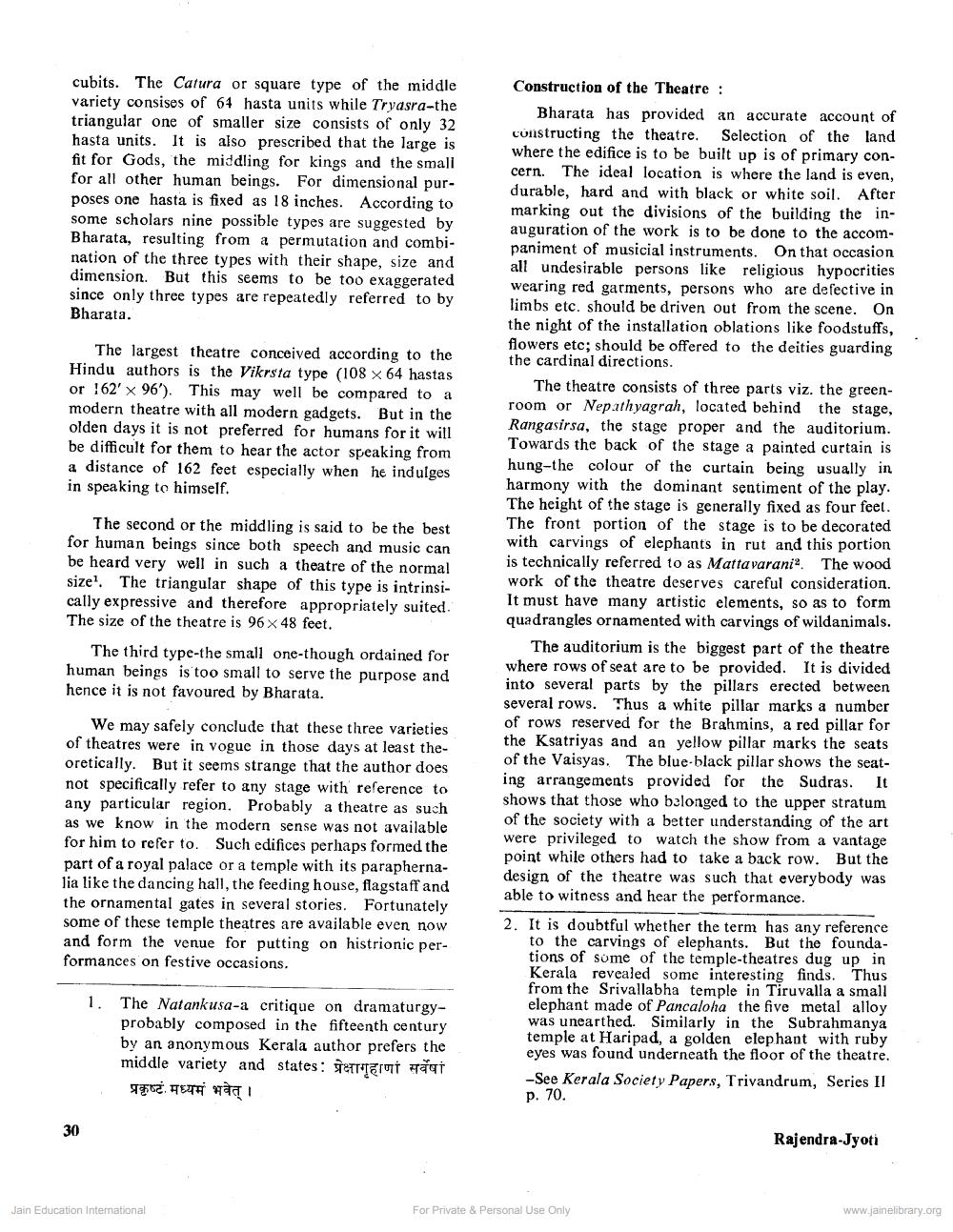________________
cubits. The Catura or square type of the middle variety consises of 64 hasta units while Tryasra-the triangular one of smaller size consists of only 32 hasta units. It is also prescribed that the large is fit for Gods, the middling for kings and the small for all other human beings. For dimensional purposes one hasta is fixed as 18 inches. According to some scholars nine possible types are suggested by Bharata, resulting from a permutation and combination of the three types with their shape, size and dimension. But this seems to be too exaggerated since only three types are repeatedly referred to by Bharata.
The largest theatre conceived according to the Hindu authors is the Vikrsta type (108 x 64 hastas or 162' x 96'). This may well be compared to a modern theatre with all modern gadgets. But in the olden days it is not preferred for humans for it will be difficult for them to hear the actor speaking from a distance of 162 feet especially when he indulges in speaking to himself.
The second or the middling is said to be the best for human beings since both speech and music can be heard very well in such a theatre of the normal size! The triangular shape of this type is intrinsically expressive and therefore appropriately suited. The size of the theatre is 96 x 48 feet.
The third type-the small one-though ordained for human beings is too small to serve the purpose and hence it is not favoured by Bharata.
Construction of the Theatre :
Bharata has provided an accurate account of constructing the theatre. Selection of the land where the edifice is to be built up is of primary concern. The ideal location is where the land is even, durable, hard and with black or white soil. After marking out the divisions of the building the inauguration of the work is to be done to the accompaniment of musicial instruments. On that occasion all undesirable persons like religious hypocrities wearing red garments, persons who are defective in limbs etc. should be driven out from the scene. On the night of the installation oblations like foodstuffs, flowers etc; should be offered to the deities guarding the cardinal directions.
The theatre consists of three parts viz. the greenroom or Nepathyagrah, located behind the stage, Rangasirsa, the stage proper and the auditorium. Towards the back of the stage a painted curtain is hung-the colour of the curtain being usually in harmony with the dominant sentiment of the play. The height of the stage is generally fixed as four feet. The front portion of the stage is to be decorated with carvings of elephants in rut and this portion is technically referred to as Mattavarani The wood work of the theatre deserves careful consideration. It must have many artistic elements, so as to form quadrangles ornamented with carvings of wildanimals.
The auditorium is the biggest part of the theatre where rows of seat are to be provided. It is divided into several parts by the pillars erected between several rows. Thus a white pillar marks a number of rows reserved for the Brahmins, a red pillar for the Ksatriyas and an yellow pillar marks the seats of the Vaisyas. The blue black pillar shows the seating arrangements provided for the Sudras. It shows that those who belonged to the upper stratum of the society with a better understanding of the art were privileged to watch the show from a vantage point while others had to take a back row. But the design of the theatre was such that everybody was able to witness and hear the performance. 2. It is doubtful whether the term has any reference
to the carvings of elephants. But the foundations of some of the temple-theatres dug up in Kerala revealed some interesting finds. Thus from the Srivallabha temple in Tiruvalla a small elephant made of Pancaloha the five metal alloy was unearthed. Similarly in the Subrahmanya temple at Haripad, a golden elephant with ruby eyes was found underneath the floor of the theatre. -See Kerala Society Papers, Trivandrum, Series II p. 70.
We may safely conclude that these three varieties of theatres were in vogue in those days at least theoretically. But it seems strange that the author does not specifically refer to any stage with reference to any particular region. Probably a theatre as such as we know in the modern sense was not available for him to refer to. Such edifices perhaps formed the part of a royal palace or a temple with its paraphernalia like the dancing hall, the feeding house, flagstaff and the ornamental gates in several stories. Fortunately some of these temple theatres are available even now and form the venue for putting on histrionic performances on festive occasions.
1.
The Natankusa-a critique on dramaturgyprobably composed in the fifteenth century by an anonymous Kerala author prefers the middle variety and states: प्रेक्षागृहाणां सर्वेषां प्रकृष्टं मध्यमं भवेत्।
Rajendra-Jyoti
Jain Education Intemational
For Private & Personal Use Only
www.jainelibrary.org




